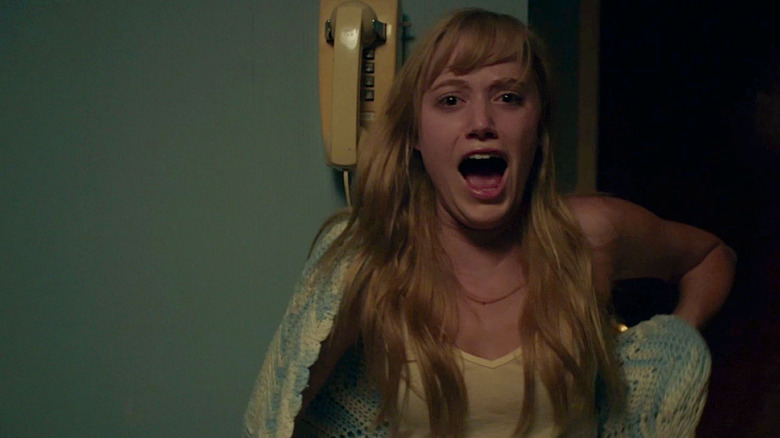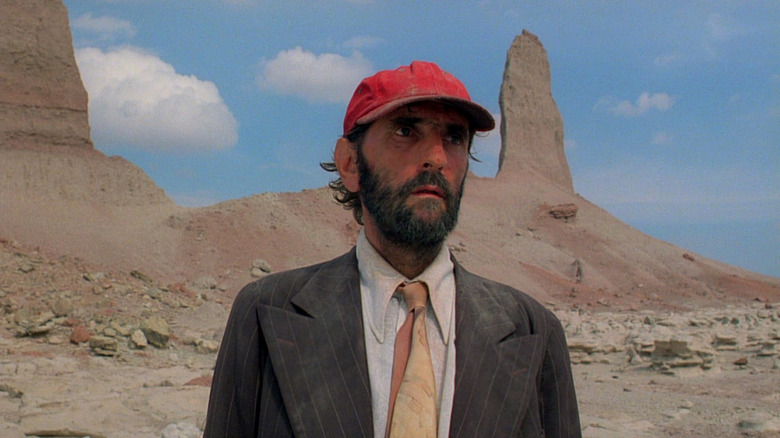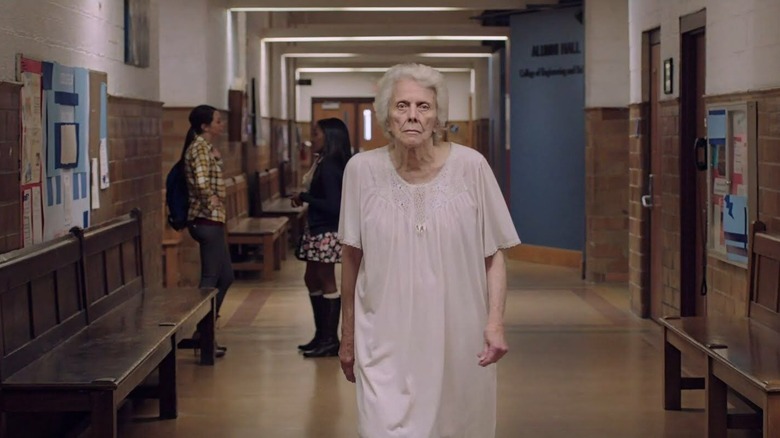It Follows' Biggest Influence Is Far From A Horror Film
David Robert Mitchell's 2014 film "It Follows" has something of a complicated mythology. When a character has sex, they pass a haunting onto their partner. While haunted, the newly "infected" person sees stone-faced people — often just ordinary random people, sometimes people they know — appear in the distance. The "ghost" will walk toward them at a normal pace. It will follow them. If it catches up, the infected will die. If the infected person has sex with someone new, the ghost will move to them in turn. However, if the secondarily infected person dies by the ghost's hand (we see a ghost's victim with gashes and broken limbs), the ghost will come back around to the original person. There doesn't seem to be a cure.
This is clearly a metaphor for sexually transmitted diseases, although it could also be interpreted as a symbol for sexual guilt. "It Follows" is set in and around Oakland University in Rochester Hills, MI, and the economic deterioration of that area also feeds into the film's symbolism, making it a criticism of capitalism and the ghosts of ordinary people that financial ruin can leave behind.
Mitchell was clearly influenced by the likes of John Carpenter when making "It Follows." The film's incessant, pounding synth score is evocative of Carpenter's electronic horror troposphere heard in "Prince of Darkness," "Escape from New York," and "They Live," and his choice of wide angles and slow-moving shadowy background figures brought to mind the Shape standing behind shrubs and among laundry in early scenes of "Halloween."
On top of that, in an interview with Rolling Stone conducted at the time of the film's release, Mitchell also revealed that he was also influenced by an unlikely film, and one that is not at all horrific: Wim Wenders' 1984 film "Paris, Texas."
Paris, Texas
Wim Wenders' 1984 film "Paris, Texas" has something of a complicated mythology. A man (Harry Dean Stanton) stumbles out of the desert, like Christ at the end of Lent, seemingly mute and in a trancelike state. This is Travis. He is eventually reunited with his brother Walt (Dean Stockwell) who has been looking after Travis' young son ever since his mysterious disappearance four years earlier. Over the course of the film, Travis will slowly reconnect with his son, and the two of them will go on a road trip to seek out the boy's mother, who has also been absent for four years. This is a deeply touching tale of reconnecting, but more so of penance and purification. Not to reveal too much, but by the end of "Paris Texas," Travis is seated in a booth at a nude peep show — an ersatz confessional — unloading his most grievous sins to a woman who could stand in for any number of Biblical figures.
"Paris, Texas," like "It Follows," presents America as a desolate place. It once thrived, but economic ruin has flattened the landscape into a place that allows for evil — or evil acts — to exist. True, one is a ghost story and the other is a tale of family and personal redemption, but both tap into guilt, and — when focused — one can see something of a tonal similarity between the two.
Another key feature in both films is the sight of single lost souls walking toward the camera out of a banal landscape. "Paris, Texas" opens with Travis wandering slowly out of the desert, not too differently from the way the "ghosts" approach the protagonist of "It Follows" (played by Maika Monroe). David Robert Mitchell reveals that he was indeed influenced by that shot.
Wenders, Carpenter, Cronenberg
Of course, in "It Follows," the sight of someone merely walking toward you is played for paranoia and fear, not Christ-like imagery or mystery. Mitchell admits in that same interview that such a notion — of someone waaaaaaalking toward you — terrifies him, largely based on a memorable nightmare he had as a child. But when it came to composing wide shots ("It Follows' was filmed in a Cinemascope 2.39:1 aspect ratio) he watched "Paris, Texas" as a reference. Oddly, "Paris, Texas" was presented in a traditionally European 1.66:1 aspect ratio.
That means "It Follows" is influenced by Carpenter, Wenders, and — thanks to the film's sexual themes — Cronenberg.
Canada's David Cronenberg first made a name for himself in the late '70s with striking horror films like "Shivers," "Rabid" and "The Brood." The first is a film about a sexually transmitted parasite that causes madness, sexual mania, and murder. The second is about, more or less, a zombie virus brought about by an experimental medical procedure. And the third is about a woman who — let's just say it's about divorce. The spreading of acrimony as one would a virus is a common theme between early Cronenberg and "It Follows," and fans of the former will deeply appreciate the latter.
The producer of "It Follows," Laura D. Smith, talking to Rolling Stone, was coy. She claims that Mitchell was not using sex as a deliberate metaphor, nor was he intending any specific political message. Mitchell was eager to talk influences, but, like most artists, didn't want to get into the nitty-gritty of messaging or theme. This is, of course, his prerogative as the creator.
But I think we know what's up.


